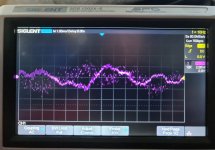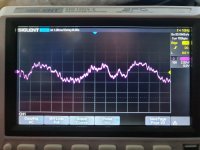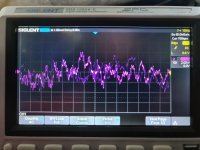Evening
so a question, that i cannot answer as i do not have that kind of knowledge, for @Mooly @Goldie99 @wg_ski or anyone else who may have an idea.
Ive never realy had a chance to test this unit, not fully at high volume,but i did today, and it was at about 3/4 volume.
I was getting quite a bit of audible distrotion, especialy in the midrange.
so i compared it with a standard 3020 series 20, and this was definatly better, but only slightly.
I then tried it with a 3240pe that has the class G final output @8ohms (so it engaged that part of the output) and that was a different story, hardly any distortion.
Is it that the output of the 3240 is just better?
Could it be because i lowered the bias to around 70ma to eliminate that 'hiss' i was getting, and it was getting realy hot over 100ma.
or is it that, it is what it is because of the nad's design?
Its quite noticible.
Lower the volume to around 1/2 and all is good.
I used 2 different sets of speakers, and it was the same.
I wouldnt normaly play at those sort of levels TBH ,but i wanted to make sure it didnt overheat etc, and see what it sounded like.
Just thought i would ask
cheers
so a question, that i cannot answer as i do not have that kind of knowledge, for @Mooly @Goldie99 @wg_ski or anyone else who may have an idea.
Ive never realy had a chance to test this unit, not fully at high volume,but i did today, and it was at about 3/4 volume.
I was getting quite a bit of audible distrotion, especialy in the midrange.
so i compared it with a standard 3020 series 20, and this was definatly better, but only slightly.
I then tried it with a 3240pe that has the class G final output @8ohms (so it engaged that part of the output) and that was a different story, hardly any distortion.
Is it that the output of the 3240 is just better?
Could it be because i lowered the bias to around 70ma to eliminate that 'hiss' i was getting, and it was getting realy hot over 100ma.
or is it that, it is what it is because of the nad's design?
Its quite noticible.
Lower the volume to around 1/2 and all is good.
I used 2 different sets of speakers, and it was the same.
I wouldnt normaly play at those sort of levels TBH ,but i wanted to make sure it didnt overheat etc, and see what it sounded like.
Just thought i would ask
cheers
Hard to say but my suspicions would come back to stability I'm afraid.
You might actually see something on the scope looking at the audio across the speaker such as a thickening or 'furriness' to the scope trace. It may well only be doing something like this when currents rise.
The weird 'hiss' that reduced when you lowered bias current and the running hot and now this. All these could well have stability at the root of the problem.
You might actually see something on the scope looking at the audio across the speaker such as a thickening or 'furriness' to the scope trace. It may well only be doing something like this when currents rise.
The weird 'hiss' that reduced when you lowered bias current and the running hot and now this. All these could well have stability at the root of the problem.
In your shoes I would take up measurements from speaker terminals (via attenuators) using REW.Is it that the output of the 3240 is just better?
The results should tell you the way.
It does look clean as far as I can tell off a picture. Can you hear the distortion when taking these images?
You could also try a quick test into a dummy load with a sine wave. You could connect the speaker at the same time across the load via say a 100 ohm resistor so you could hear if the quality deteriorated.
You could also try a quick test into a dummy load with a sine wave. You could connect the speaker at the same time across the load via say a 100 ohm resistor so you could hear if the quality deteriorated.
So are we really looking at 4 volts peak? It’s not possible to get 40 off a 30V supply, so it might be. That’s not much volume and I wouldn’t expect it to be heating up over quiescent. By the time you get a hot heat sink there’s some clipping.well im no expert but these look quite clean to me.
3/4 volume
Worth remembering that although there's a suspicion of instability, if you can hear hiss, then so (probably) can the scope - and hiss can be fairly smooth looking, it's really just white-noise without the bass.well im no expert but these look quite clean to me.
3/4 volume
So I'd try with a pure sine wave at various levels, not music, and see if you ever see a non-siney wave out of it (i.e. with the hiss superimposed). It may be that one of the FETs is not happy and it's clipping early or something.
I'd also try it mono, and plot both channels to see if they are the same.
I'd also try it with no signal, and the volume pot at various positions to eliminate that..
- Home
- Amplifiers
- Solid State
- Last, but (hopefully) best ever modified and complete NAD 3020


